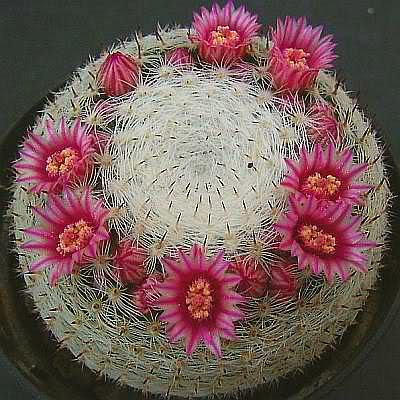First description by Quehl;
Monatschrift für kakteenkunde 19: 188, (1909).
Body: Solitary, globose at first, later cylindric. 50 - 200 mm high and 50 - 70 mm in diameter, apex sunken, dull green.
Roots: Fibrous.
Sap: With latex.
Tubercule: Cylindric, firm, 6 - 7 mm long and 2 mm wide.
Axil: Naked or with a little bit wool and bristles.
Radial spine: 20 - 26, 1 - 3 mm long, bristle-like, somewhat horizontal radiating, white.
Central spine: 0 - 2, sometimes one pointing upwards and longer, 1 - 3 mm long, awl - shaped, straight, smooth, thicker and dark brown at base, brown with black tip.
Flower: Funnelform, 10 - 12 mm long and in diameter, carmine pink with darker midstripe.
Fruit: Club-shaped, deep dull pinkish-red, 10 - 15 mm long and 2 - 3 mm wide. Ripens 7 months after flowering. Selfsterile.
Seed: Brown, club-shaped, 1 mm long and 0,8 mm wide. Hilum small and subbasal.
Minimum temperature: 5 - 10C.
Habitat Substrate: Between rocks in humus soil.
Geographic Distribution: Mexico; Queretaro near Higuerillas, San Luis Potosi near Realejos. Altitude 1500 - 2800 meu
Comments: Psuedoperbella was unfindable for years. But founded back later by Wendel Minnich in Queretaro, let's hope it will one day be accepted as being a good species. Pseudoperbella is not a rarity in our collections and seems to be true to the description.
Bibliography: Reppenhagen: Die gattung Mammillaria nach dem heutigen stand meines wissens 1987; 222, 564 - 565.

